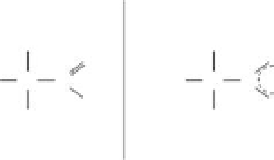Chemistry Reference
In-Depth Information
7.1.3 a
mino
a
CidS
Amino acids
can exist in either
(1) unionized or (2) a zwitterionic form, whereby a
salt is formed when there is a proton transfer from the acidic carboxyl function to the
basic amino group to create the zwitterion, represented in Figure 7.3. The isoelectric
points of amino acids, in general, range from 5.5 to 6.2. Titration curves showing the
neutralization of these acids by added base, and the change in pH during the titration
are illustrated in Figure 7.4.
All the natural amino acids listed in Figure 7.1, with the exception of proline, are
primary amines. They all possess a stereochemical center except for the amino acid
glycine, thus, they are all chiral. Using the Fischer projection, the configurations of
the chiral amino acids in nature are the same and defined as the L-coniguration
by Fischer.
CO
2
H
H
2
N
H
R
L-Amino Acid
CH
3
CH(NH
2
)CO
2
H <=> CH
3
CH(NH
3
)
(+)
CO
2
(-)
1
2
H
H
O
O
+
α
α
H
2
N
CC
H
3
N
CC
-
OH
O
R
R
FIGURE 7. 3
The zwitterionic forms of amino acids.
Alanine
14.0
12.0
10.0
8.0
6.0
12.0
-
CO
2
pK
a
2
= 9.69
+
10.0
8.0
6.0
4.0
2.0
H
2
NH
CH
3
-
pH > 10
CO
2
+
x pI = 6.01
H
3
NH
CH
3
4.0
2.0
pK
a
1
= 2.34
pH ≈ 6
CO
2
H
+
H
3
NH
CH
3
0.0
0.5
1.0
Equivalents of OH
-
1.5
2.0
2.5
pH < 2
FIGURE 7. 4
Graph showing titration curves and the various isoelectric points of amino acids.










Search WWH ::

Custom Search